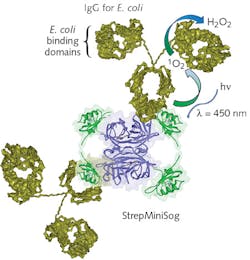Protein-based photocatalyst uses blue light to selectively disinfect water

Although ultraviolet (UV) light is playing a significant role in destroying both water and surface bacteria, UV light can also harm good bacteria and even DNA. Recognizing this disadvantage of UV light and the possible toxic effects of nanoparticle-based disinfection, researchers from the University of Cincinnati (Cincinnati, OH) have instead introduced a reactive oxygen-generating fluorescent protein called StrepMiniSOG (SMS) that can be made to bind to specific bacteria (when paired with specific antibodies) and produce hydrogen peroxide (H2O2) to selectively destroy only those bacteria when illuminated with blue light, leaving good bacteria and cellular structures intact.
Disinfection studies confirmed that targeting Listeria monocytogenes in a mixed culture of both E. coli and Listeria effectively removed the target while leaving the E. coli unharmed. After 30 minutes of exposure to 450 nm light, 80% of the Listeria were neutralized in solution using the SMS-antibody mixture and 99.99% were gone after 1.5 hours. Because the protein mixture is nontoxic and degrades with the chemical reaction to its targeted bacteria, it would be safe for human ingestion as well as general water and surface disinfection. In addition, the photocatalyst does not produce the carcinogenic disinfection by-products associated with chlorine disinfectants and can be used with a visible light source, enabling safe disinfection on surfaces like human skin. References: www.uc.edu/news/NR.aspx?id=24078 and http://dx.doi.org/10.1371/journal.pone.0162577.

Gail Overton | Senior Editor (2004-2020)
Gail has more than 30 years of engineering, marketing, product management, and editorial experience in the photonics and optical communications industry. Before joining the staff at Laser Focus World in 2004, she held many product management and product marketing roles in the fiber-optics industry, most notably at Hughes (El Segundo, CA), GTE Labs (Waltham, MA), Corning (Corning, NY), Photon Kinetics (Beaverton, OR), and Newport Corporation (Irvine, CA). During her marketing career, Gail published articles in WDM Solutions and Sensors magazine and traveled internationally to conduct product and sales training. Gail received her BS degree in physics, with an emphasis in optics, from San Diego State University in San Diego, CA in May 1986.